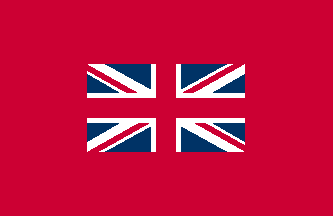
Last modified: 2022-10-22 by bruce berry
Keywords: kenya | witu protectorate |
Links: FOTW homepage |
search |
disclaimer and copyright |
write us |
mirrors
 image
by António Martins, 28 Nov 1999. First hoisted on 31 July 1893
See also:
image
by António Martins, 28 Nov 1999. First hoisted on 31 July 1893
See also:
The Witu forest lies within the protectorate of British East Africa.
Its flag is a red field upon which is centered a Union Jack, about half
as long and half as wide as the field itself.
Josh Fruhlinger, 20 Feb 1996
Witu was a protectorate established c.1890 on the coast of East Africa.
It was part of the mainland territories of the Sultan of Zanzibar that
came under British control as a result of the Anglo-German Heligoland Treaty.
It was probably the territory that became known as the Protectorate of
Kenya when the East Africa Protectorate became Kenya Colony in 1920. The
flag may not have come into use until c.1905. A letter of that year in
PRO file ADM 116/1063B reported that the Consul General at Zanzibar had
adopted a red Arab flag with a small Union Jack in the centre for the Protectorate
of Witu.
As drawn, the flag was 37:57 with a central Union Jack of 15:27.
David Prothero, 8 May 1999
According to a Philatelic Atlas I have, Witu includes the off-shore
islands of Patta, Manda and Lamu. The atlas depicts the territory as bordering
Zanzibar (coastal possessions) to the south. The territory at the north
of Kenya, that was ceded to Italy, and called Oltre Giuba in Italian (across
the Jiuba river = Transjubaland) is farther north. A contemporary atlas
shows the three islands, and the city of Lamu, as well as a small town
Witu, on the north coast of Kenya.
Herman De Wael, 2 Dec 1999
There are coloured prints of the jack and ensign of "German government
vessels engaged in East African trade", in the 1892 amendments to the Admiralty
Flag Book. The jack is the merchant flag with a plain blue anchor in the centre
of the white band, and the ensign a Reichskriegsflagge with a plain blue
anchor in the lower hoist. [National Archives (PRO) ADM 116/353]
"The German civil ensign - a horizontal tricolor black white red -
flew over Witu and was carried by askaris."
A photograph shows the German flag being dipped to the Sultan of Witu
when he reviewed askaris in front of his palace c1882.
[Article "The Forgotten Flags of Witu" by James Marill in (probably)
an issue of the Flag Bulletin]
David Prothero, 28 Oct 2003
I have now found out that the flag, design of which was agreed by the
Sultan of Zanzibar's First Minister and the Imperial British East Africa
Company Representative at Lamu, was first hoisted on 31 July 1893.
Source: National Archives (PRO) ADM 116/1063D.
David Prothero, 6 Dec 2003
Wasn't the Protectorate in the coastal strip much more than the former
Witu? Witu had formerly been a small German protectorate, exchanged in
1890, along with Zanzibar, for Helgoland and the Caprivi Strip. As I understand
it the remaining Kenyan coastal strip, which was formerly under the control
of the Sultan of Zanzibar, had already become a British protectorate before
the exchange. Mombasa and other parts of this protectorate had never been
part of Witu as far as I can see.
Ned Smith, 26 Sep 2005
After 1920 the interior of the country was a colony, but the coastal
strip and the formerly separate Protectorate of Witu, remained a protectorate.
Witu was a relatively small area to the north of the coastal strip leased
from the Sultan of Zanzibar by the Imperial British East Africa Company.
Under the terms of the 1890 agreement with Germany, Witu was to remain
separate from other British territories. This seems to have been
observed until the Colonial Office took over from the Foreign Office in
1905, and was not formally abandoned until 1920.
David Prothero, 27 Sep 2005